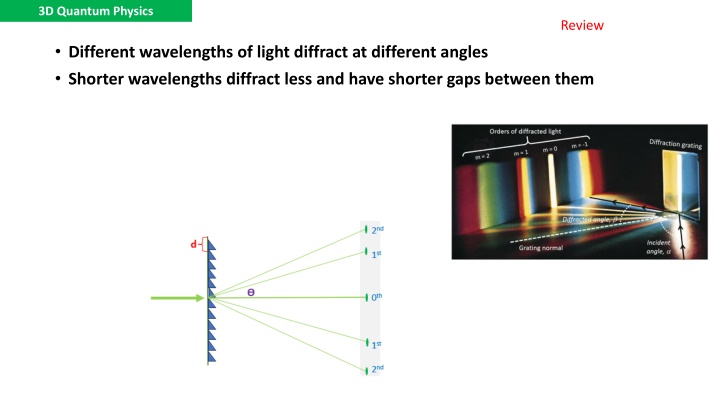
Understanding Quantum Physics: Wave Behavior of Particles
Explore the fascinating world of quantum physics and delve into the behavior of particles as waves. Learn about different wavelengths of light, De Broglie's wave hypothesis, electron diffraction, and how electrons can behave as waves, all explained with insightful images.
Download Presentation

Please find below an Image/Link to download the presentation.
The content on the website is provided AS IS for your information and personal use only. It may not be sold, licensed, or shared on other websites without obtaining consent from the author. If you encounter any issues during the download, it is possible that the publisher has removed the file from their server.
You are allowed to download the files provided on this website for personal or commercial use, subject to the condition that they are used lawfully. All files are the property of their respective owners.
The content on the website is provided AS IS for your information and personal use only. It may not be sold, licensed, or shared on other websites without obtaining consent from the author.
E N D
Presentation Transcript
3D Quantum Physics Review Different wavelengths of light diffract at different angles Shorter wavelengths diffract less and have shorter gaps between them
3D Quantum Physics De Broglie s wave hypothesis states that particles of matter moving under the right conditions may behave like a wave.
3D Quantum Physics LouisDe Broglie s wavelength: the wavelength of the particle (wave): Planck s constant 6.63 10 34 9.11 10 31 ? = ? = Wavelength in m momentum of an electron = mass speed
3D Quantum Physics LouisDe Broglie s wavelength: the wavelength of the particle (wave):
3D Quantum Physics LouisDe Broglie s wavelength: the wavelength of the particle (wave). Example: what is the De Broglie s wavelength of a proton travelling at 10% the speed of light mass of a proton =1.67 10-27 kilograms
3D Quantum Physics LouisDe Broglie s wavelength: the wavelength of the particle (wave). Example: what is the De Broglie s wavelength of a proton travelling at 10% the speed of light mass of a proton =1.67 10-27 kilograms 6.63 10 34 = ? = 1.67 10 27 0.1 3 10 8 = 1.32 10 14 m
3D Quantum Physics Electron diffraction
3D Quantum Physics Electrons can behave as waves
3D Quantum Physics Scanning Electron microscope: Electrons can behave as light with very short wavelength, this makes them much more useful in microscopy. By adjusting the voltage of the SEM , we can obtain electron wavelengths in the sub-nanometer range and thus can observe infinitesimally small objects. The minimum sized object that can that can be imaged by a wave must be at least same size as the wavelength
3D Quantum Physics Assumptions: The faster an electron is travelling ,the shorter is its wavelength (more frequency) Electrons are deflected by magnetic fields Electrons are accelerated using electric fields De Broglie s wavelengths applies only to very small moving particles
3D Quantum Physics Think about it: A proton, an electron, and a helium particle are moving with a speed v, which one has the largest de Broglie s wavelength ? Why is an electron microscope more suitable than an optical microscope for seeing objects less than 1 m in size? If all matter has a wave-like nature, why is this wave-like characteristic not observable in our daily experiences?
